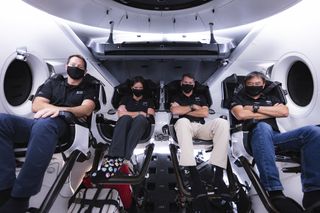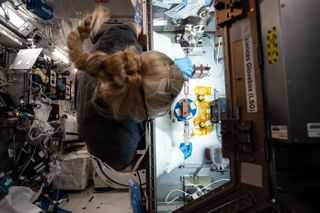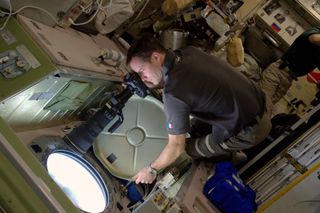SpaceX's Crew-2 astronauts will conduct more than 200 science experiments in space

CAPE CANAVERAL, Fla. — Four astronauts are headed to the International Space Station later this week, where they'll spend six months aboard the orbital outpost conducting research for scientists back on Earth. During their six-month stay, the international crew will conduct more than 200 different research investigations.
NASA astronauts Shane Kimbrough and Megan McArthur, along with European Space Agency (ESA) astronaut Thomas Pesquet and Japan Aerospace Exploration Agency (JAXA) astronaut Akihiko Hoshide, make up the quartet of astronauts that will join the Expedition 65 crew already on board the space station. The astronauts will launch on the Crew-2 mission to the orbiting lab in a SpaceX Crew Dragon spacecraft this Thursday (April 22), and you can watch the launch and prelaunch activities live here on Space.com.
During their stay, the crew will work on hundreds of experiments, including new medical research. Those experiments will help scientists here on Earth combat diseases and help space agencies around the world better understand how space affects the human body so they can better prepare astronauts for future, longer-duration space travel to the moon.
Related: Meet Crew-2: The 4 space-bound astronauts launching aboard SpaceX's Crew Dragon
Among the research investigations, the crew will assist with are several tissue chip experiments. Biomedical researchers have created small systems of cells and tiny organoids that grow on tissue chips and mimic the actions of those cells inside the human body.
The crew will also test a new portable ultrasound device that's designed to help astronauts on long-duration missions to the moon and eventually Mars.
The astronauts are launching atop a SpaceX Falcon 9 rocket, marking the third crew launch for SpaceX in less than a year. The private spaceflight company is one of two commercial partners that NASA has hired to launch its astronauts as part of its commercial crew program — Boeing is the other. (Boeing has yet to launch astronauts on its Starliner crew capsule; a second uncrewed Starliner test flight is scheduled to launch late this summer.)
Get the Space.com Newsletter
Breaking space news, the latest updates on rocket launches, skywatching events and more!

One major goal of the commercial crew program is to launch more astronauts to the station so that NASA is able to do more science. By having a fourth U.S. crew member on the station, NASA says it's able to double the amount of science being conducted at the orbiting lab.
"We didn't want crew time to continue to be the limiting factor on station [in regards to the amount of research being done] ... which is what was happening," David Brady, associate program scientist for the International Space Station program at NASA's Johnson Space Center in Houston, said in a news conference on Monday (April 19).
"The numbers have shown that we are getting the benefits out of having that additional crewmate," Brady added.
Having that extra astronaut has many benefits. Kirt Costello, chief scientist for the International Space Station program at NASA Johnson, told Space.com that if some crewmembers are busy with other tasks, say an hours-long spacewalk, then time spent doing research investigations would not be lost, as there would be an extra astronaut onboard to devote time to science.
"More bodies equals more science," he told Space.com. "We are very glad to have the extra bodies on orbit."
Those extra bodies are great for testing out new systems on the station as well. Recent cargo resupply missions have delivered new environmental systems (like a new toilet, new urine collection system, and water reclamation system) to the station and with an unusually high population on station (11 following the Crew-2 launch), the systems are put to the test.
"When you're looking at how a system performs, having those extra bodies is a plus," Costello told Space.com. "We can't sustain those numbers long term, but they do provide great data short-term."
Let's take a look at some of the science investigations that the Crew-2 astronauts will perform during their six-month stay on orbit.
Tissue chips in space

Tissue chips contain small groups of cells or tiny organoids that help researchers mimic different kinds of diseases in order to test new treatments or better understand how specific bodily systems respond to spaceflight.
The chips can be incredibly helpful in the drug development process, Lucie Low, a researcher at the National Institutes of Health, said during a prelaunch science briefing on Monday (April 19).
"Tissue chips are really helpful tools that we can use to try and understand human health and disease," she added.
One tissue chip investigation will look at kidney function, paying close attention to kidney stone formation. The formation of these stones happens very quickly in microgravity and researchers want to understand why.
Another chip investigation will look at the body's immune system. The teams will look at lung function and how the body's immune system responds to microgravity. According to Low, after the past year, this type of research is more important than ever.
Low explained that some of the tissue chip investigations will be testing out drugs and other therapeutics and that the space environment allows researchers to better understand how the cells respond to different therapeutics.
"One of the things the teams will be looking at is how these drugs affect the very fast cellular changes we see in microgravity," she said. "We're going to [hopefully] be able to understand how these drugs work and on a much faster timescale than we could on Earth."
Earth observations

The Crew-2 astronauts are going to continue a tradition that's been carried on by astronauts since humans first went into space — photographing the Earth. NASA and other space agencies around the world have a fleet of satellites that are trained to image the planet and measure how it's changing. But only the International Space Station has astronauts that can hold cameras and photograph the Earth from 250 miles (400 kilometers) overhead.
Related: French astronaut Thomas Pesquet's amazing photos from space (gallery)
For the past two decades, there's been a continuous human presence on the station, and during that time, astronauts have captured more than 3.5 million images of the Earth, contributing to one of the longest-running records of how Earth has changed over time.
"These images are very important, especially for disaster response," William Stefanov, NASA's ISS Program Scientist for Earth Observations, said in Monday's news conference. "It's one of the crew's primary targets."
Stefanov explained that in the case of hurricanes and cyclones, the crew can not only photograph the storm throughout its life cycle but also the areas along a storm's projected path. So officials will have pre-storm imagery, imagery of the storm itself, and then the imagery of the area after the storm passes so that emergency officials can begin to assess the damage.
"We've been supporting the international disaster response community in responding to these types of events since 2012," he said.
New solar arrays
Currently the space station is powered by eight solar arrays that were launched in December 2000, with an expected lifespan of 15 years. While the arrays have plenty of life left in them, the station's power requirements are growing thanks to commercial partners. With more technologically advanced payloads and an increasing number of research investigations, the station will soon need even more power than those arrays can provide.
The new ISS power augmentation project will supply six additional arrays to the orbital outpost. The arrays are based on the rollout solar array technology that was first tested on the station in 2017 as part of the SpaceX CRS-11 cargo resupply mission.
Each new array will launch onboard a SpaceX Dragon, folded in its trunk. They will launch in pairs and once unfolded in orbit, they will measure 60 feet (18 meters) long by 20 feet (6 m) wide, and produce at least 20 kilowatts of power.
The installation of each array will take two spacewalks to complete, for a total of 12 spacewalks over the next two years.
CHIME
Another investigation, called CHIME (short for "Characterizing Human Immunodeficiency in Microgravity Environments Microgravity"), will look more closely at the human immune system and how it responds in microgravity.
"The CHIME investigation could help identify potential causes of immune system dysfunction and lead to ways to prevent or counteract it, helping space travelers as well as those with compromised immune systems on Earth," Shantanu Jain, a student at New York University Abu Dhabi and lead investigator on the CHIME project, said in Monday's news conference.
The project, which is sponsored by the United Arab Emirates, will look at how microgravity affects the differentiation of monocytes into macrophages, which are specialized immune system cells. The results could help researchers take steps towards identifying the possible causes for an observed weakened immune response in microgravity, Jain said.
NASA and SpaceX are targeting a launch from Pad 39A at NASA's Kennedy Space Center on Thursday, April 22 at 6:11 a.m. (1011 GMT). If all goes as scheduled, the crew would arrive at the space station just under 24 hours later and remain there for six months before returning to Earth. You can watch the launch live here on Space.com, courtesy of NASA TV.
Follow Amy Thompson on Twitter @astrogingersnap. Follow us on Twitter @Spacedotcom or Facebook.
Join our Space Forums to keep talking space on the latest missions, night sky and more! And if you have a news tip, correction or comment, let us know at: community@space.com.

Amy Thompson is a Florida-based space and science journalist, who joined Space.com as a contributing writer in 2015. She's passionate about all things space and is a huge science and science-fiction geek. Star Wars is her favorite fandom, with that sassy little droid, R2D2 being her favorite. She studied science at the University of Florida, earning a degree in microbiology. Her work has also been published in Newsweek, VICE, Smithsonian, and many more. Now she chases rockets, writing about launches, commercial space, space station science, and everything in between.
